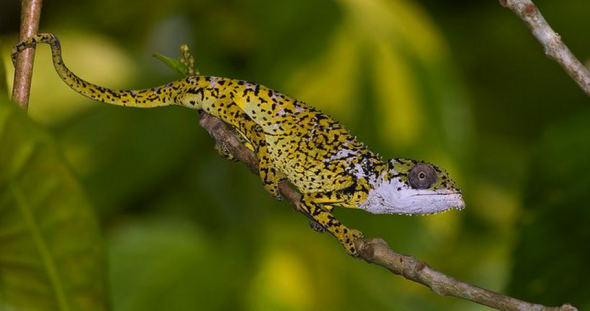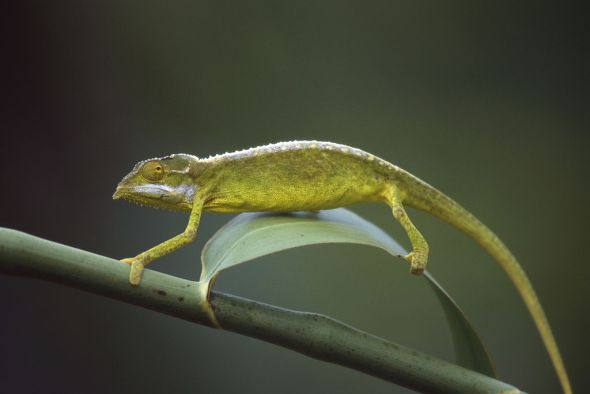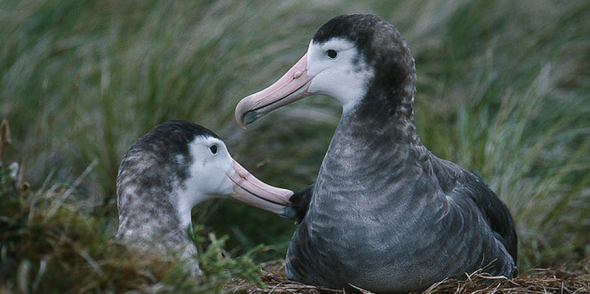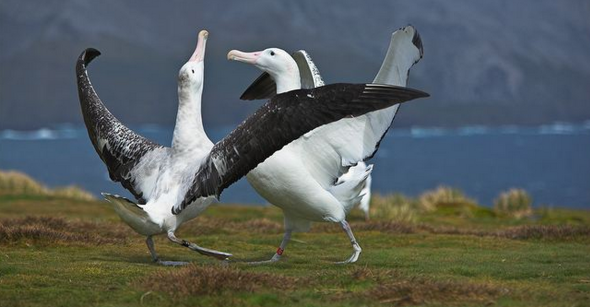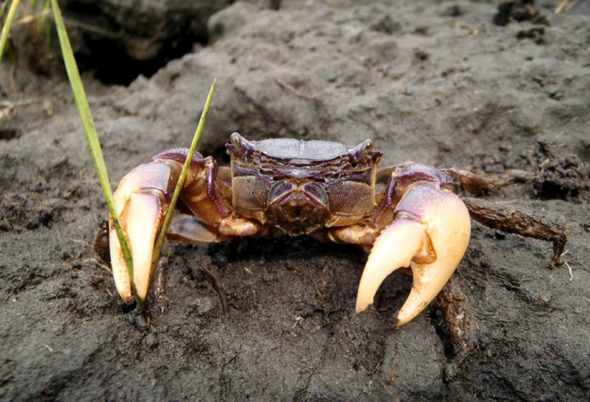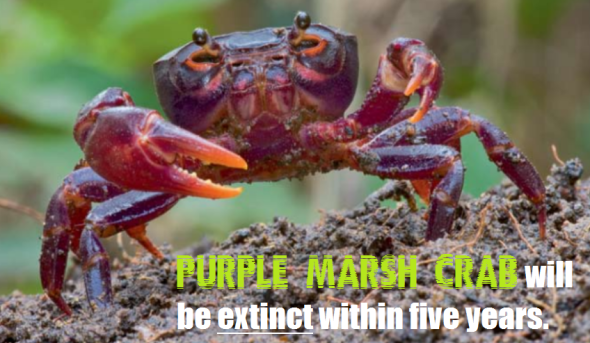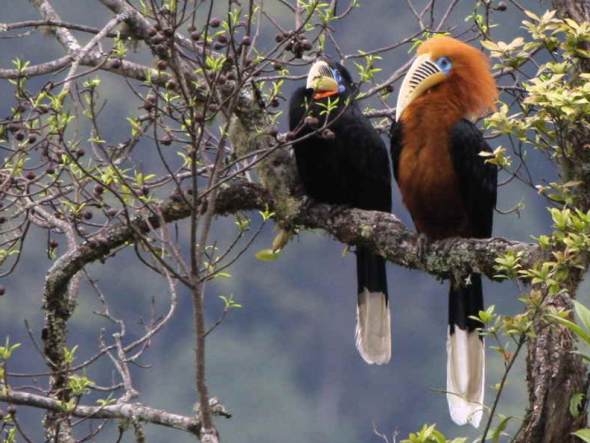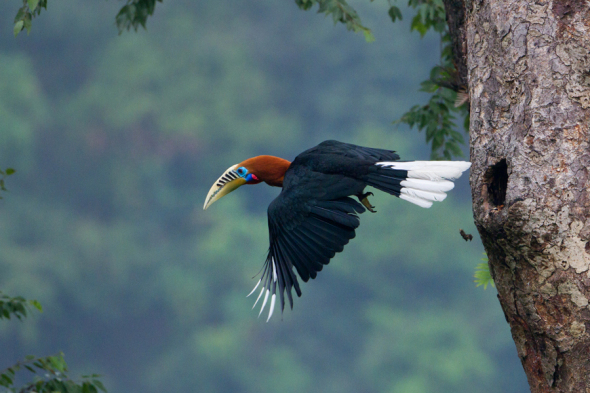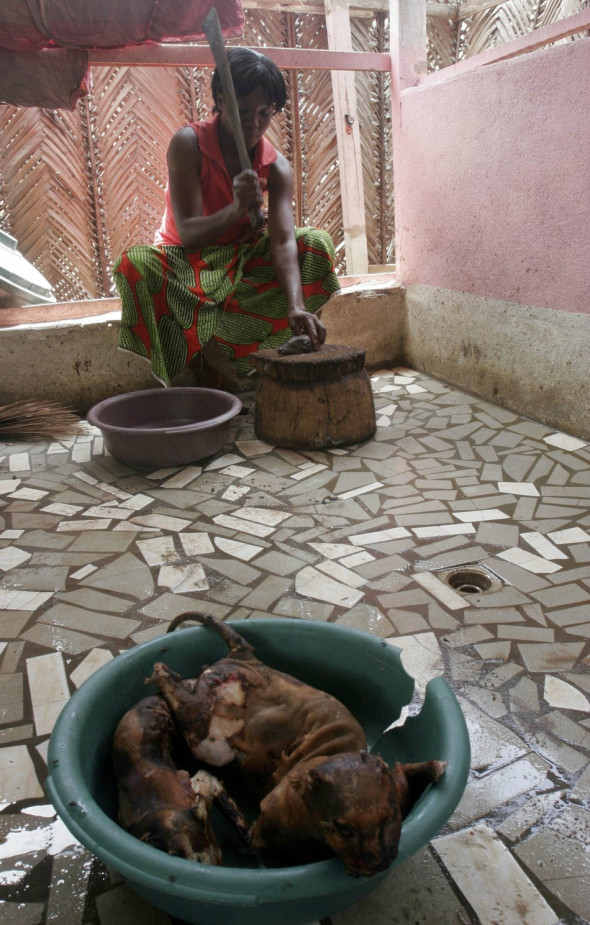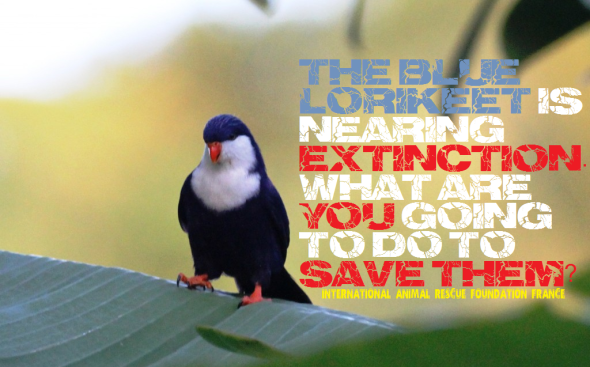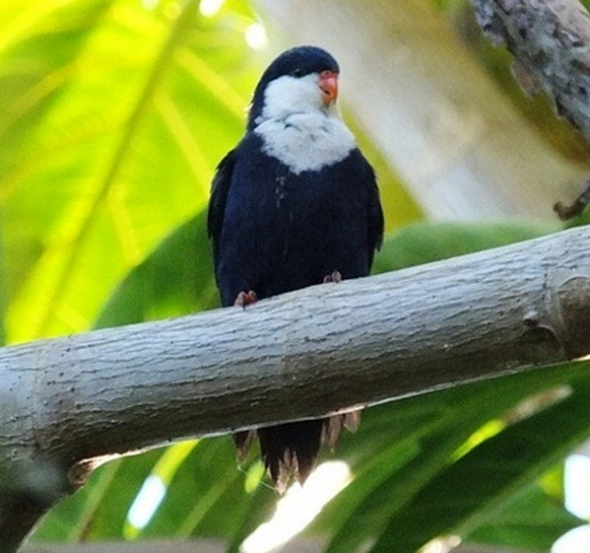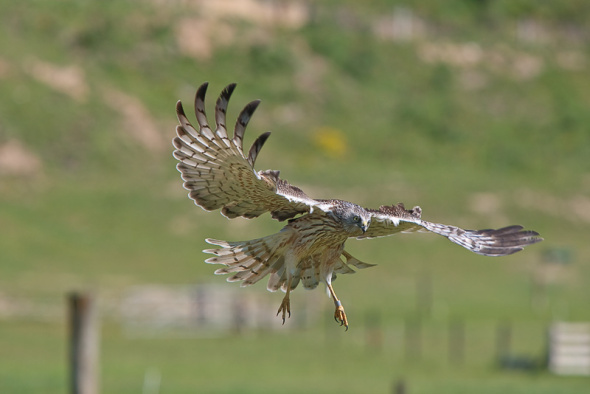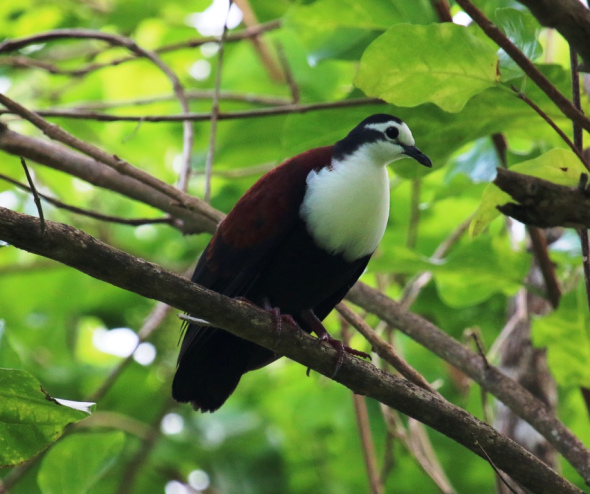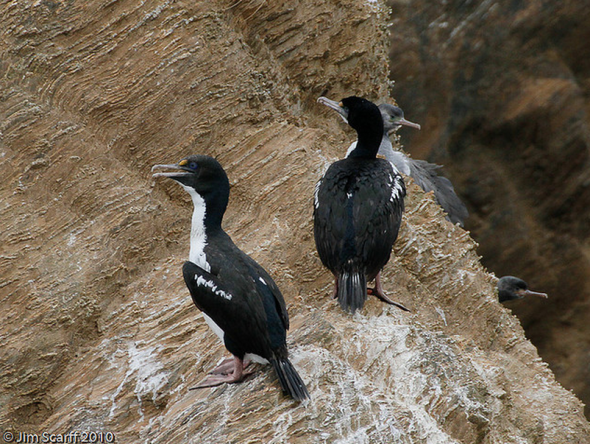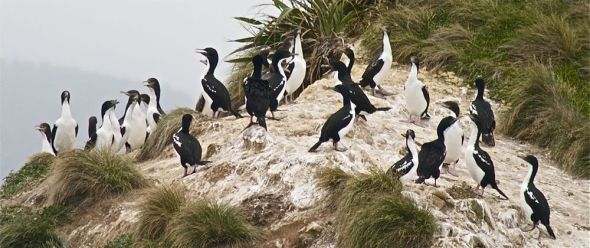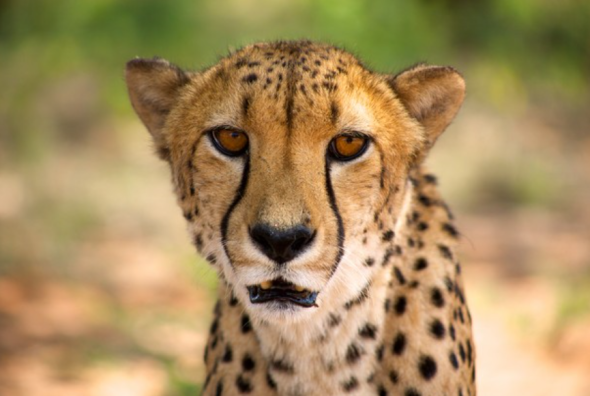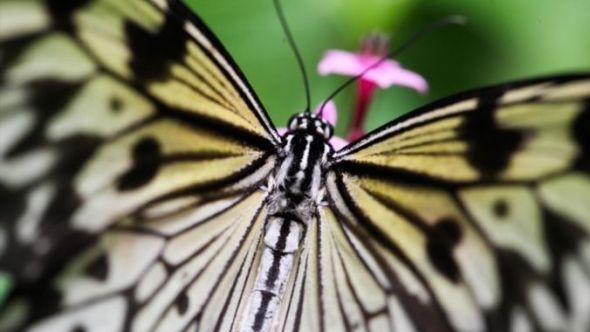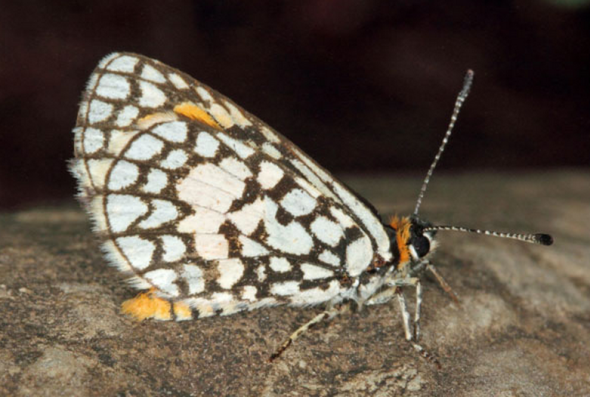Endangered Species Monday: Archaius tigris
Endangered Species Monday: Archaius tigris
This Mondays Endangered Species watch Post (ESP) I document on yet another African species of wildlife that hunting revenue is not helping to preserve. The Tiger Chameleon was identified back in 1820 by Dr Heinrich Kuhl (September 17, 1797 – September 14, 1821) was a German naturalist and zoologist. Kuhl was born in Hanau. He became assistant to Coenraad Jacob Temminck at the Leiden Rijksmuseum van Natuurlijke Historie. (Image: Credited to Henrick Bringsoe, A tigris).
In 1817 he published a monograph on bats, and in 1819 he published a survey of the parrots, Conspectus psittacorum. He also published the first monograph on the petrels, and a list of all the birds illustrated in Daubenton’s Planches Enluminées and with his friend Johan Coenraad van Hasselt (1797–1823) Beiträge zur Zoologie und vergleichenden Anatomie (“Contributions to Zoology and Comparative Anatomy”) that were published at Frankfurt-am-Main, 1820.
Commonly known as the Tiger Chameleon or Seychelles Tiger Chameleon the species is currently listed as [endangered] which is not uncommon as like many Chameleons within the Seychelles their range is shrinking by the year or being overrun by invasive botanical species.
Endemic to the Seychelles the species has been listed as endangered since 2006 of which populations trends are unknown. Much documentation often cites the species at “comparatively” low density, however one must not take this as factual until a true population count is seen. It has been alleged that for every [five hectares] there is possibly 2.07 individuals which isn’t good ‘if true’ since the island is only 455 km2.
From what we know the species remains undisturbed where there aren’t invasive Cinnamon trees identified as the Cinnamomum verum. However where C. verum is spreading the Tiger Chameleons habitat is under threat from this invasive plant. There is a negative correlation between Chameleon density and the presence of cinnamon, suggesting this invasion is detrimental to chameleon populations. Negative correlation is a relationship between two variables such that as the value of one variable increases, the other decreases.
The Tiger Chameleon’s main endemic range on the Seychelles islands is Mahé, Silhouette and Praslin. A historical record from Zanzibar (Tanzania) is erroneous. It occurs from sea level to 550 m asl, in areas of the islands that have either primary or secondary forest, or in the transformed landscape if there are trees and bushes present. Although they are currently estimated to have a restricted distribution on each island (following survey transects conducted by Dr Gerlach if anecdotal observations from transformed landscapes (e.g. degraded areas outside the areas surveyed) are valid, then the distribution would be larger than mapped at present.
To date the only [non-active] conservation actions that I am aware of are within the Vallee de Mai on Praslin which is currently not a protected national park. Fortunately the species is protected to some degree in the Morne Seychelles, Praslin and Silhouette National Parks. The primary threat within non-protected areas is as explained invasive Cinnamon which seems to be posing similar threats to both small reptilians, insects and birds on the islands and mainland Madagascar.
While the species has been in the past used as a trade animal it was alleged that there were no Cites quotes since 2000 - 2014. However from 1997 - 2013 a total of twelve live specimens were legally exported [despite the species threatened at risk status]. Cites allowed the twelve species to be exported for use within the pet trade which I myself find somewhat confusing. Two specimens were exported to Germany in 1981 with the remainder [10] sent to Spain. I am a little perplexed as to why these twelve specimens were legally exported, furthermore I have found no evidence or follow up data that would satisfy me in believing this export was even worthwhile for the species currently losing ground within their natural habitat.
From 1981 -2010 a further 98 dead specimens were legally exported for scientific zoological projects. Then in 1982 a single live specimen was legally exported with Cites permit for experimental purposes. While I cannot [again] locate any evidence or reason as to why this single specimen was exported alive - I must make it clear that Cites is sympathetic to Huntington Life Science’s and various other animal experimental laboratories. However this doesn’t prove that Cites has exported to anyone of these experimental research centers, it is merely my assumption.
Image: Archaius tigris
No other trade is reported out of the Seychelles, although re-export of specimens imported to Germany and Spain has been reported to Switzerland and South Africa, respectively (UNEP-WCMC 2014). This species is present and available in limited quantities in the European pet trade, and illegal trade and/or harvest may occur on a limited basis. ‘A’ report handed to myself from an [anonymous 2014] officer from the office of UNEP states that a population of some 2,000 specimens has been recorded [2014] however there is yet again no census historical data to back these claims/report up. I again must point out that if its proven there are no fewer than [2,000 Tiger Chameleons] remaining in the wild and, Cites is allowing export then Cites is going to come under immense pressure from International Animal Rescue Foundation Africa because exporting live animals for pet trade at such ‘alleged’ depressed populations - is neither helping the species nor supportive of conservation practices.
Threats
The main threat is habitat degradation as a result of the invasion by alien plants species, especially Cinnamomum verum, principally on Mahé and Praslin. Cinnamon is displacing other vegetation, it is present all over the islands and it is the fastest growing, heaviest seeding plant in most areas and is changing the composition of the forests. Currently it makes up 70-90% of trees in Seychelles forests, reaching >95% in some areas. For Archaius tigris, the cinnamon trees provide a normal structure of vegetation, but the invaded forests support a massively diminished insect population, somewhere in the region of 1% of normal abundance. This excludes invasive ants which are the only common invertebrates associated with cinnamon.
In addition, the cinnamon produces a denser canopy than native trees, giving deeper shade which excludes forest floor undergrowth (other than cinnamon seedlings), and this also is a factor in the reduced insect abundance. The Chameleons are found on cinnamon and in cinnamon invaded areas, as long as there is a wide diversity of other plants and a dense undergrowth. In fact, rural gardens can provide habitat for the Chameleons, because these tend to be more diversity in terms of flora, and therefore can support invertebrate fauna.
Dr Jose C. Depre
Environmental and Botanical Scientist.
Endangered Species Friday: Diomedea amsterdamensis - An Ocean of Grief.
Endangered Species Friday: Diomedea amsterdamensis
This Friday’s (ESP) Endangered Species watch Post I dedicate to one of the most stunning and adorable of all plane like birds. Listed as [critically endangered] and identified back in 1983 by South African Dr Jean Paul Roux whom is a Marine Biologist studying Zoology, Systems Biology and Marine Biology at the University of Cape Town, South Africa Jean Paul Roux works full-time at the Department of Biological Sciences, Cape Town. (Image D. amsterdamensis fledglings)
(Image: Birdingblogs.com)
Commonly identified as the Amsterdam Albatross or Amsterdam Island Albatross the species was listed as [critically endangered] back in 2012. This gorgeous bird is endemic to the French Southern Territories of which its populations are continuing to decline at a rapid pace. Populations were estimated at a mere 170 individuals which in turn ranks as the worlds most endangered species of bird. Out of the 170 individuals there are a total of 80 mature individuals consisting of 26 pairs that breed annually.
Between 2001-2007 there were a total of 24-31 breeding pairs annually, which leaves a slightly lower population count today of around 100 mature individuals. Back in 1998 scientists stated that there were no fewer than 50 mature individuals if that. The Amsterdam Albatross doesn’t naturally have a small population however qualified for the category of [critically endangered] due to this reason when identified in 1983. Furthermore pollution, habitat destruction and disease remain pivotal factors that’s decreasing populations furthermore. The video below from MidWay island explains a little more about pollution and birds of this caliber.
Its quite possible that there could be more unidentified groups within the local territory or elsewhere, unfortunately as yet there is no evidence to suggest the Amsterdam Albatross is located anywhere else, however there have been sightings, which do not necessarily count as the species being endemic to countries the bird may have been noted within.
The species breeds on the Plateau des Tourbières on Amsterdam Island (French Southern Territories) in the southern Indian Ocean. An increase of populations was documented via census back in 1984, a year after identification. Marine Biologists have stated that population sizes may have been more larger when its range was more extensive over the slopes of the island.
Meanwhile in South Africa satellite tracking data has indicated the Amsterdam Albatross ranges off the coast of Eastern South Africa to the South of Western Australia in non-breeding pairs. There have been some [possible] sightings over Australia through to New Zealand too. Meanwhile South Africa “may” have its first breeding pair this must not be taken as factual though. Back in 2013 a nature photographer photographed an Amsterdam Albatross off the Western Cape of South Africa which is the very first documented and confirmed sighting [2013].
AN OCEAN OF GRIEF
Breeding is biennial (when successful) and is restricted to the central plateau of the island at 500-600 m, where only one breeding group is known. Pair-bonds are lifelong, and breeding begins in February. Most eggs are laid from late February to March, and chicks fledge in January to February the following year.
Immature birds begin to return to breeding colonies between four and seven years after fledging but do not begin to breed until they are nine years of age. The Amsterdam Albatross exact diet is unknown, but probably consists of fish, squid and crustaceans. During the breeding season, birds forage both around Amsterdam Island and up to 2,200 km away in subtropical waters which is something of interest. During the great Sardine Run many aquatic species consisting of birds, seals, sharks and whales hit the South African oceans hard for sardines. So I am calling on my fellow South African friends to please be on the lookout for this rather elusive bird.
Read more here on the Avian Biology.
Image: Amsterdam Albatross mating ritual, credited to Andrew Rouse.
Diomedea amsterdamensis, is quite a large albatross. When described in 1983, the species was thought by some researchers to be a sub-species of the wandering albatross, D. exulans. Bird Life International and the IOC recognize it as a species, James Clements does not, and the SACC has a proposal on the table to split the species. Please refer to the link above on Avian Biology which will explain more on the bird and its current classification.
More recently, mitchondrial DNA comparisons between the Amsterdam albatross, the wandering albatross Diomedea exulans, the Antipodean albatross D. antipodensis and the Tristan albatross D. dabbenena, provide clear genetic evidence that the Amsterdam albatross is a separate species.
Threats
Degradation of breeding sites by introduced cattle has decreased the species’s range and population across the island. Human disturbance is presumably also to blame. Introduced predators are a major threat, particularly feral cats. Interactions with longline fisheries around the island in the 1970s and early 1980s could also have contributed to a decline in the population.
Today the population is threatened primarily by the potential spread of diseases (avian cholera and Erysipelothrix rhusiopathiae) that affect the Indian Yellow-nosed Albatross Thalassarche carteri population 3 km from the colony. Infection risks are very high and increased chick mortality over recent years suggests the population is already affected.
The foraging range of the species overlaps with longline fishing operations targeting tropical tuna species, so bycatch may also still be a threat, and a recent analysis has suggested that bycatch levels exceeding six individuals per year would be enough to cause a potentially irreversible population decline. Having a distribution on relatively low-lying islands, this species is potentially susceptible to climate change through sea-level rise and shifts in suitable climatic conditions. Plastic pollution has also been noted as problematic.
International Animal Rescue Foundation Africa and International Animal Rescue Foundation France are currently working on projects to reduce more plastic within bird habitat that has never been visited by the organisation before. The current plight of bird habitat and plastic pollution within the Pacific ocean needs to be worked on by everyone, furthermore addressed immediately.
To date all twenty two species within the four genera of Albatross are heavily threatened with extinction. There remains no species at present that is listed as [least concern]. The future is indeed very bleak for all 22 species and something we now need to work on and towards to preserve Albatross’s before extinction occurs within a decade for the vast majority of all twenty two species and sub-species.
Thank you for reading.
Please share to make aware the plight of this stunning bird and the remaining twenty two species too.
Dr Jose C. Depre.
Botanical and Environmental Scientist.
A planet without birds is a world not worth living within anymore. Daily I am traumatized and deeply disturbed at viewing the destruction we have caused to these stunning animals and, their natural habitat. I am pained, deeply frustrated and infuriated at international retail companies whom preach good yet practice negligence killing off via plastic pollution our species of birds. Jose Depre
Endangered Species Monday: Afrithelphusa monodosa.
Endangered Species Monday: Afrithelphusa monodosa
Warning: Extinction is now Inevitable
This Mondays (E.S.P) -Endangered Species watch Post I focus on a species of fresh water crab that’s rarely spoken about within the theater of conservation, or animal rights forums. Identified by Mr Bott from which I know little on and about this particular species of marsh crab is currently listed as endangered. Rarely do I document on a species of animal that I and other conservationists know will be extinct within the next five years. My aim for this Monday’s endangered species column is to raise awareness about the plight of this little creature, in a way I hope will force Cites and the Guinea government to now implement emergency evasive action to halt extinction immediately. (Image: Purple Marsh Crab, photographer unknown)
I must also point out that one must not confuse the [common name] of this species [above], identified back in 1959, to that of the United States [Purple Marsh Crab]. Professor Linnaeus created the nomenclature system for a reason, and yet again I am seeing two species of animals that hold the same common names being confused with one-another. Sesarma reticulatum is not under any circumstances related to the Afrithelphusa monodosa pictured above and below.
Endemic to Guinea the species was listed back in 1996 as [critically endangered]. However since the last census was conducted back in [2007] the Purple Marsh Crab has since been submitted into the category of [endangered]. Unfortunately as yet there remains no current documentation on population size, furthermore from the 1996 census, marine conservation reports suggest that no fewer than twenty specimens have been collected from the wild. To date the ‘estimated’ population size stands at a mere 2.500 mature individuals.
Back in 1959 Mr Bott identified the specimen as Globonautes monodosus however from 1999 the species was re-named as Afrithelphusa monodosa. The Purple Marsh Crab is one of only five species in the two genera of which belong to a very rare group of fresh water crabs that are still endemic to the Guinea forests within the block of Western Africa. All five specimens within the two genera are listed as either [endangered or critically endangered], and as such its quite likely that all five specimens will become extinct within the next five to eight years, or possibly even sooner. It is without a doubt that one of the next species on the planet to go extinct will be the Purple Marsh Crab.
Allegedly new specimens have been discovered since [1996] however these reports are somewhat sketchy. When I last documented on the specimen back in 2010 there were no conservation efforts or any projects in the planning process that would help preserve the crabs future survival. We are now in 2015 and I have yet to witness any conservation projects planned or taking place, which I find rather frustrating. As explained the species will be extinct within a matter of years of which the Convention on International Trade of Endangered Species (Cites) should be protecting.
A. monodosa lives within the Guinea swamps and all year round wetland habitat within the northwestern Guinea. The original vegetation cover found at the farmland near the village of Sarabaya where this species was recently collected lies in southern guinea savannah in the semi-deciduous moist forest zone. Specimens of A. monodosus were collected from cultivated land from burrows dug into permanently moist soil each with a shallow pool of water at the bottom. At the end of the dry season after a six-month period without rain the soil in this area nevertheless remains wet year round, so this locality either has an underground water table close to the surface, or a nearby spring. The natural habitat of A. monodosus is still unknown but presumably this cultivated land was originally a permanent freshwater marsh.
There were no nearby sources of surface water and it is clear that these crabs do not need to be immersed in water (as do their relatives that live in streams and rivers), and that A. monodosus can meet its water requirements (such as keeping its respiratory membranes moist and osmoregulation of body fluids) with the small amount of muddy water that collects at the bottom of their burrow. This species is clearly a competent air-breather and has a pair of well-developed pseudol.
Image: Credited to Piotr Naskrecki. Purple Marsh Crab.
Current threats
To be truthfully honest I feel documenting on the current threats is in reality a waste of my time because both the Guinea government and Cites have known of these threats for many years. Yet little if any actions are being taken to suppress these threats. Either way I will document on them in the hope that someone will push for protection or whip into action a protective project sooner rather than later.
To date the species hasn’t been listed on either Cites (I-II) Appendix’s, the major present and future threats to this species include habitat loss/degradation (human induced) due to human population increases, deforestation, and associated increased agriculture in northwest Guinea.
International Animal Rescue Foundation Africa propose the following actions to be undertaken immediately:
- Up to date assessment of population size and location of any new and old habitats documented.
- Surveys to asses diets, predators, diseases and behavior.
- Investigations to locate new subspecies.
- Protection zones established within the highest populated zones.
- Liaising the Guinea government for funding of conservation projects.
- Listing of the species in (I Appendix) Cites.
- Community education and awareness programs.
- Removal of healthy and gene strong species for captive breeding programs.
Crabs Role within the Eco-System
Crabs are one of the major decomposes in the naval environment. In other terms, Crabs help in cleaning up the bottom of the sea and rivers by collecting decaying plant and animal substance. Many fish, birds and sea mammals rely on crabs for a food source. Regardless of if this is one species with low individual populations or not, extinction will only harm other animals. Furthermore will reduce other species food sources. The video below depicts the [Marsh Crabs] and their normal natural environment. The species in question which is identical to the Guinea Purple Marsh Crab is not included within the video but is related to the five genera.
Thank you for reading.
Dr Jose C. Depre
Environmental and Botanical Scientist.
info@international-animalrescue-foundation.org.uk
Endangered Species Friday: Aceros nipalensis
Endangered Species Friday: Aceros nipalensis
This Fridays (ESP) - Endangered Species watch Post I have chosen to document on this stunning species known commonly as the Rufous-cheeked Hornbill, because of large population declines throughout most of the birds historical range. More awareness needs to be created with regards to this particular bird specie due to their natural habitat declining and localized extinctions that have already occurred in the past decade. Furthermore extinctions are now likely to occur within Viet Nam and [west] Thiland where hunting is the primary threat to the species.. (Image credit Ian Fulton).
Identified back in 1829 by Mr Brian Houghton Hodgson (1 February 1800 or more likely 1801– 23 May 1894) was a pioneer naturalist and ethnologist working in India and Nepal where he was a British Resident. He described numerous species of birds and mammals from the Himalayas, and several birds were named after him by others such as Edward Blyth.
Listed as vulnerable the A. nipalensis is endemic to Bhutan; China; India; Lao People’s Democratic Republic; Myanmar; Thailand and Viet Nam. Unfortunately A. nipalensis has already been declared extinct locally in Nepal. Like many large birds within this region of Asia the Rufous-cheeked (or necked) Hornbill’s populations are declining quite extensively throughout their range of which deforestation and habitat degradation and, hunting is primarily to blame.
The species has been listed on Cites Appendix (I-II) of which an estimated population census count has determined there are no less than 2,500 birds but no greater than 9,999. A survey count back in 2001 by Bird-Life International concluded that from the [estimate] above the [true] population count is actually by far more lower than previously suggested, however few conservationists are now debating this due to the birds ‘alleged’ extensive range within South East Asia.
From the Bird Life International (2001) census the organisation stated there was no fewer than 1,667 mature individuals but no greater than 6,666, which is rounded to 1,500 to 7,000 mature individuals exactly. Since the last 2001 census its quite possible populations have increased and decreased to date.
A. nipalensis is known to inhabit the following ranges; Bhutan, north-east India, Myanmar, southern Yunnan and south-east Tibet, China, [west] Thailand, Laos and Viet Nam. The species has declined [drastically] and is no longer common throughout most of its known historical range. While we know the species is now regionally extinct within Nepal the next likely localized extinction may very well be within Viet Nam of which its populations have fallen to alarming rates.
Within [most] of Thailand where the species was quite common reports have sadly indicated the bird is no longer commonly seen, and like Viet Nam, Thailand could become the third county to see localized extinctions occurring too, the only known habitat within Thailand that A nipalensis occurs now is within west Thailand. To date reports have confirmed that within Bhutan A. nipalensis remains pretty much common of which Bhutan is known to the birds [largest] stronghold.
Healthy large populations have also been documented back in 2007 within Namdapha National Park, India, Nakai-Nam Theun National Biodiversity Conservation Area, central Laos and perhaps also Huai Kha Khaeng, [west Thailand], and Xishuangbanna Nature Reserve, China. Some conservationists have been led to believe that while populations are considered quite large within these strongholds that the species may very well be “more widespread than previously thought”. Meanwhile the species is known to inhabit north Myanmar, and there are recent records from West Bengal and Eaglenest Wildlife Sanctuary, Arunachal Pradesh, India.
Rufous-cheeked Hornbill commonly resides within broad-leaved forest, some reports have also indicated the species to be present within dry woodland too. Mating and nesting normally occurs from the months of March to June within large wide girth trees, the very trees that the species depends on though are being felled throughout most of the Hornbills historical range.
Image: Rufous-necked-Hornbill (Photographer unknown)
Major Threats
Its dependence on large trees for feeding and nesting makes it especially susceptible to deforestation and habitat degradation through logging, shifting cultivation and clearance for agriculture. Furthermore, viable populations require vast tracts of forest to survive, exacerbating its susceptibility to habitat fragmentation. These problems are compounded by widespread hunting and trapping for food, and trade in pets and casques. Hunting is the primary threat to the species in Arunachal, India. A report from the Wildlife Extra organisation details poaching incidents with regards to Hornbills.
Wildlife Extra stated:
The unique and intriguing breeding habits that caught Pilai Poonswad attention are central to the birds’ plight. Each hornbill pair seeks out a suitable hollow – 15 to 40 metres above the ground in the trunk or branch of a Neobalanocarpus, Dipterocarpus or Syzygium tree – in which to raise a single chick. When a suitable cavity is found, the female walls herself in, using mud supplied by her mate and regurgitated food, to hatch and rear her chick. The male feeds them for the next three months and, if he fails, both mother and chick may perish. The birds consume up to 80 different kinds of fruit, scattering the seeds over many hectares of forest. With other seed-distributing animals such as monkeys now scarce, the hornbill has become pivotal in maintaining the integrity of the forest. But the birds rarely spread the seeds of the trees in which they nest: if these disappear, the hornbills too will vanish – and the trees and plants they help propagate will soon follow.
Click the link above via the [report] to read more on this very fascinating conservationist.
My name is Dr Jose Carlos Depre, MD, B.Env.Sc, BSBio, D.V.M. I myself have been working within bird, tree kangaroo and pachydermata conservation, rescue and reporting for over fifteen years.
Within these unique, wonderful and exhilarating years I have witnessed one of my favorite species of animals [birds] declining to worrying levels that is now so concerning it has led to sleepless nights for many years. Should we continue to see such catastrophic population decreases of birds we’ll eventually witness alarming declines of plants and trees. The same applies with insects and herbivorous mammals too.
Like insects birds are incredibly important for both human and animal survival. The vast majority of all bird species rely on plants for their staple diet. On consuming fruits, leaves, flowers Etc, the very seeds within the birds diet of life needed to continue seed dispersal will be lost should all bird populations go extinct. Should this occur we selfish humans will then become the Planets seed disperses. Think about that next time you fell a tree or rip a plant up.
Dr Jose. C. Depre
Environmental and Botanical Scientist.
Thank you for reading and please share fare and wide to create as much awareness for all Hornbills as possible.
Embassy Day: For Cats and Dogs in the Horrific Meat Trade.
EMBASSY DAY: 17TH SEPTEMBER 2015 WWW.SAYNOTODOGMEAT.NET
Did you know on the 17th September 2015 from 11:00am the Australian organisation www.saynotodogmeat.net, registration 49 860 343 527 will be hosting peaceful demonstrations around the globe within nine major cities? Embassy Day forms the first (governmental) lobbying in relation to #OperationUnite 2016. Embassy Day will be the organisations second largest demo since April 4th 2015. Back in April Say No To Dog Meat made history by hosting the worlds largest anti pet meat demo in over twenty five countries.
On the 4th April 2015 the Say No To Dog Meat family hit the streets internationally in their thousands marching for dogs and cats in the horrific pet meat trade. The main April protests were non-governmental, however was a reminder that should the (eight governments) the organisation are lobbying not respond to the polite requests from the Aussie organisation. The next step would be Embassy Day, September 2015. Finally after Embassy Day, the organisation will then begin gearing up for phase two of Operation Unite 2016 that will be held October 2nd and 3rd 2016. Followed up with #OperationUnite comes the new #lovefamily campaign too.
Image: (SNTDM) supporter, #lovefamily campaign.
September 17th 2015 will see demonstrators lobbying South Korean embassies within Los Angeles, United States and Ottawa, Canada. Then in New York the Indonesian embassy, followed up with the Cambodian embassy in Seattle, United States will be demonstrated. Meanwhile within the United Kingdom the Vietnamese embassy will be peacefully protested in London, followed up with the Indian consulate in Belfast, Northern Ireland. The Nigerian embassy in Johannesburg, South Africa will follow soon after. The Thailand consulate within Perth and Philippines consulate in Brisbane, Australia will be peacefully lobbied too.
Donna Armes, campaign manager and director confirmed that all embassy consulate generals and ambassadors had been sent communications months before Embassy Day was planned. Furthermore the campaign manager stated a second electronic communication had been sent and received by embassy staff informing them about the peaceful protests, and why the organisation has been forced to lobby all nine embassies. Embassy staff, consulates and ambassadors have failed to acknowledge the Aussie organisations peaceful plans which is a little frustrating but then the organisation didn’t expect a reply anyway.
Say No To Dog Meat volunteers and directors will begin the ‘peaceful demonstrations’ with an up to date speech on current and past issues in relation to both ‘Asian and African’ dog and cat meat trade outside of each embassy. After the main speech the public can stay or depart of which the organisations volunteers and directors will then be handing into the embassies all data and petitions.
Image: Nigeria, woman prepares dog carcass for [404 joint delicacy, peppered dog soup].
Each petition contains from 10,000 to 200,000 signatures. Statistics on pet meat consumption death rates, virus and disease, regulations and violations of current standing law, predictive model data research, food hygiene violations will be handed into the consulate generals and ambassadors too. Presidential letters will also feature within the pack of which each government has a set six to eight months to respond. The organisation is not expecting an immediate or even positive response, of which OPERATION UNITE will continue to go ahead come October 2016.
For the very first time in history the Indian and Nigerian embassies will be lobbied by the organisation in relation to the Indian, Nagaland and Nigerian pet meat trades. Nigeria is the largest dog meat consuming country on the continent of Africa and third largest on the planet. Furthermore deaths from consumption of diseased or rabies infested pet meat has skyrocketed this year alone with some eighty people dead already. Meanwhile the Indian Nagaland state loses on average an estimated forty people a year via the direct consumption of rabies infested dog meat. Rabies is also on the rise in both pet meat consuming zones. India is where 85% of all human rabies deaths occurred between 1995 and 2004. Over this period there were 21404 rabies deaths a year there. Death rates for 2014 are yet to be seen.
“About 3.5 million dog bites are registered every year in India. The Government cannot give vaccine free of cost to all people. From 2006, the price of vaccine has increased…”
Despite many protests against the South Korean Bok Nal pet meat trade that began in June and ended in the first week of August. The South Korean government took no notice of expert knowledge, scientific data or petitions handed to them. Instead they allowed traders to continue the horrific disease riddled trade, and took little notice of their own laws and guidelines implemented to protect dogs and cats in meat trade. Dare we ask what the point is in introducing animal protection laws, just to allow native citizens to continue violating them?
From 2013-2015 Say No To Dog Meat has vainly lobbied the Viet Nam health minister and president Trương Tấn Sang to bring an end to the pet meat trade. On the 19th August 2014 reports issued by the (World Health Organisation) confirmed that deaths rates had increased slightly to forty (per year), however its estimated that some one hundred people die annually from rabies infection.
Despite the Aussie organisation sending more than enough scientific evidence to the Vietnamese health minister and president the trade continues. From 1995-2004 the then death rate from rabies in Viet Nam stood at some 1,550. Since 2004 the Vietnamese pet meat trade has increased. Death rates continue to increase within the country from the direct consumption of diseased pet meat, statistics from 2014 showed many of these deaths were infant related either bitten by dogs on private land or from consuming rabied infected dog and cat meat.
March 16th 2009 the Vietnamese government were handed third party data from; National Institute of Infectious and Tropical Diseases and the National Institute of Hygiene and Epidemiology in Hanoi, Viet Nam that stated; “Most Rabies deaths in Vietnam were from the direct Butchering and eating of either dog or cat meat”.
Vietnamese researchers confirmed;
“In Viet Nam, dogs with rabies have been detected in dog slaughterhouses and workers at dog slaughterhouses are vaccinated against rabies as part of the national programme for rabies control and prevention. However, the private slaughter of dogs is relatively common in the country which increases rabies infection rates”
“Vietnamese doctors already consider dog slaughtering to be a risk factor for rabies transmission, but it is important that other health care workers and policy makers, both in- and outside Vietnam, are aware of this risk factor”
Dog and cat meat trade is now finally illegal within Thailand, unfortunately this doesn’t stop traffickers from snatching dogs and transporting from Thailand into the Viet Nam. Yes the trade may indeed be illegal, but again our own investigative journalists have located street traders openly selling and smuggling unhygienic meat in rural communities.
Back in 2013 [Life With Dogs] stated; “In the past week, Cambodia, Laos, Thailand and Vietnam have signed a deal with the intention of ending the importation and sale of dogs to be used as food. This move was initiated by their governments because of the involvement of animal welfare group Asia Canine Protection Alliance. The ACPA is comprised of four notable animal groups: Animals Asia, Change for Animals Foundation, Humane Society International and Soi Dog Foundation.
We are now in 2015 and as yet [SpeakupFortheVoiceless] and [SayNoToDogMeat] have yet to witness any such decrease of trade within Cambodia, Vietnam and Laos. Trafficking and snatching of pet dogs and cats continues within Thailand feeding the trade within the Viet Nam and China. Why has it taken from 2013 to do nothing? One only has to walk the streets of Hanoi, Saigon, Hoi An and Ben Tre to witness dog meat traders more than active. On June 30 2015, police from Sakol Nakorn intercepted a truck carrying the butchered remains and carcasses of more than 100 dogs. The truck was heading for Tha Rae, [the traditional home of Thailand’s dog meat trade]. Yet trade is illegal!
Within the Philippines the government has introduced tough and stringent laws with regards to pet meat traffickers and peddlers (Please click the links to view current data from government). Say No To Dog Meat recognizes the Philippines as one of few Asiatic countries on the continent that has taken the pet meat trade seriously. Despite a law banning the killing and maltreatment of dogs (Animal Welfare Act of 1998), dog-eating and the industry that supplies it continues particularly in the northern part of the country. Back in June 23 2013, some 12 dogs were rescued in San Pedro Laguna, according to the Department of Agriculture (DA).
The Philippines government aims to eliminate the country’s dog meat trade by 2016, AKF Head and Legal Counsel Heidi Caguioa told Rappler [2014]. Eradication means no more dog meat traders and no more dog meat restaurants. Say No To Dog Meat will be lobbying the Philippines embassy within Brisbane, Australia calling on the government to strengthen the current Animal Welfare Act 1998 and Rabies Act 9482.
Finally Say No To Dog Meat volunteers will be lobbying the Indonesian embassy calling on the government to enact law and close down all known dog meat markets. The Indonesian dog meat trade is allegedly associated with the Minahasa culture of northern Sulawesi, Maluku culture and the Bataks of northern Sumatra, where dog meat is considered a festive dish, usually reserved for occasions such as weddings and Christmas. While Say No To Dog Meat and our comrades Animal Defenders Indonesia, Surabaya Tanpa Dog Meat, Bali Adoption and Rehabilitation Center would like to believe this, the trade on dog and cat meat actually occurs every day of the month.
This September 2015 please unite with Say No To Dog Meat this Embassy Day 2015. For more information please contact the organisation here via email: contact@saynotodogmeat.info
Image: Say No To Dog Meat, Team Perth.
Chief Executive Officer.
contact@saynotodogmeat.info
Endangered Species Monday: Vini peruviana.
Endangered Species Monday: Vini peruviana
This Monday’s endangered species watch post (ESP) I document on a rather elusive bird that is rarely spoken about within the conservation theater or among animal rights organisations. Listed as (vulnerable) the species was formally identified by Professor Philipp Ludwig Statius Müller (April 25, 1725 – January 5, 1776) was a German zoologist. (Image V. peruviana, photographer Tara)
Statius Müller was born in Esens, and was a professor of natural science at Erlangen. Between 1773 and 1776, he published a German translation of Professor Linnaeus’s Natursystem. The supplement in 1776 contained the first scientific classification for a number of species, including the dugong, guanaco, potto, tricolored heron, umbrella cockatoo, red-vented cockatoo, and the enigmatic hoatzin. He was also an entomologist.
Despite the birds high population size the Blue Lorikeet-scientifically named as Vini peruviana is under threat from feral cats, accidental introduction of black rats and violent storms that hit the birds native range frequently causing untold damage and catastrophic destruction to the specie habitat. Furthermore the ‘swamp harrier’ remains an all out threat to Blue Lorikeet’s range which has led to wide range species decline. Swamp Harriers predate on the Blue Parikeet mainly due to the birds color.
Endemic to the Cook Islands and French Polynesia, Blue Lorikeet population sizes are declining quite fast of which drastic conservation measures are now required to control feral cats and the accidental introduction of black rats, not forgetting measures to either reduce swamp harriers or introduce a non-endangered prey for the harrier. The last survey which I believe was undertaken sometime back in 2012 showed a ‘global population’ estimated to be at 7,200 to 9,000 individuals. Which is still quite high, however not high enough to stop the species qualifying for the classification of (endangered).
Taking into consideration range and overall total population size (at an estimate) the species falls into the ‘band’ of 2,500 to 9,000 individuals. This equates (exactly) to 1,677-6,666 ‘mature individuals’ rounded to 1,500-7,000 mature individuals. Summarizing; the exact total population size could be as low as 1,500 but no greater than 7,000 mature individuals (which is extremely concerning).
Blue Lorikeet’s have been recorded within twenty of the south-east Polynesia islands, unfortunately on seven of these islands the species has since been declared officially extinct. The species now remains sparsely distributed on some thirteen islands of which is threatened by rats, feral cats and the swamp harrier. We now know the species is situated within the Society Islands (formerly all), the northern atolls of the Tuamotu Archipelago (both French Polynesia), and Aitutaki (Cook Islands).
Image: Blue Lorikeet - Vini peruviana
Within the Society Islands conservation teams estimated that there were some 200-400 individual pairs on the Motu One and Manuae respectively in 1973 , however this may no longer be the case. On the Maupihaa island back in 1999 conservationists that believed the species to be extinct located breeding pairs. In Tuamotus 2006 surveys have shown the following data in relation to population sizes; Kaukura (1,000), Rangiroa (1,000), Arutua (500), Apataki (200) and Tikehau (50).
Meanwhile in Tiamanu Motu in Apataki atoll a minimum 300 individuals were estimated back in 1989 (this sub-population being allegedly smaller than 10 years previously). On Aitutaki, where it was probably introduced, numbers have been estimated at under 500 pairs, 2,400 individuals and 1,000 individuals (2006).
Following the devastation of Cyclone Pat (2010) a further census was undertaken to asses the impacts of freak weather patterns and catastrophic cyclones on the species. Distance sampling surveys on the island of Aitutaki (2011) showed a decrease in population size of exactly 1,400 individuals. That’s quite a substantial decline of individuals caused directly by a single yet destructive cyclone.
Blue Lorikeets depend on coconut palms for nesting and some of its food, and will frequent cultivated areas. They also roost in palm trees, rising at dawn and calling and preening before feeding. They are usually found in small flocks of less than ten birds. They are active birds, feeding on nectar, insects, and ground forage.
Image: Swamp Harrier (Wiki) - . Circus approximans
Threats
The species’s extinction from many islands is most likely due to predation by black rat Rattus rattus and to a lesser extent, feral cats Felis catus. Blue Lorikeet’s have gone extinct from Makatea in the Tuamotus could have been accelerated by a particularly violent hurricane. Its range reduction in the Society Islands correlates with the spread of the introduced Swamp Harrier Circus approximans. The accidental introduction of black rats to the islands where Blue Loirkeet persists is a continuing threat to the species. Listed on Cites Appendix II conservation actions are under way with more projects proposed.
Thank you for reading.
Dr Jose. C. Depre
Botanical and Environmental Scientist.
Endangered Species Monday: Phalacrocorax carunculatus.
Endangered Species Monday: Phalacrocorax carunculatus
This Mondays (ESP) Endangered Species watch Post is dedicated to the Rough Faced Shag, scientifically known as Phalacrocorax carunculatus. Identified back in 1789 by Professor Johann Friedrich Gmelin (8 August 1748 – 1 November 1804) was a German naturalist, botanist, entomologist, herpetologist and malacologist. (Image credited: Jim Scarff 2010)
Listed as (vulnerable) the Rough Faced Shag doesn’t appear to be listed on either appendix (I) or (II). This Monday I have chosen to document on P. carunculatus as the species is incredibly rare. Thankfully conservation efforts and improvements in relation to protection of habitat have finally stabilized the birds population count. For once in many of my articles I can finally write on a bird that’s populations are not in decline. However, as explained the species is considered one of New Zealand’s rarest specimens.
Endemic to New Zealand the species derives from the family of Phalacrocoracidae. Locals commonly refer to the species by other names such as; New Zealand King Shag or King Shag. P. carunculatus qualified for the listing of vulnerable due to its very small (stable) population size where its restricted to four islands only.
From 1992 to 2002 the estimated number of birds living on all four islands stood at a mere c645 individuals (Est). A further 100-130 breeding pairs were counted too, which is equates (roughly) to 299-1000 ‘mature individuals’. Taking all individuals and breeding pairs into consideration followed up with the last census, it concluded that some 375- 1500 individuals remain on all four islands. Had drastic conservation measures not been implemented the species could have gone extinct.
Conservation practices on all four islands have been undertaken extremely well despite the fact populations are depressed. I personally applaud the New Zealand Government and Department of Environment for their efforts, and thank them for continuing future conservation and bird management projects.
Image: Rough Faced Shag small colony.
92% of the population resides on White Rocks, Sentinel Rock, Duffers Reef and Trio Islands, in the Marlborough Sounds, with two smaller colonies off D’Urville Island. Furthermore surveys on islands have confirmed that populations have remained stable over the last fifty years.
Breeding normally occurs on small rock stacks and islets, the primary diet component is said to be left eyes flatfish. However the Rough Faced Shag will also feed on other marine aquatic specimens too.
Colonies now reside within wildlife sanctuaries that are clearly signposted on the islands reminding tourists and any wannabe poachers to stay clear of Rough Faced Shag habitat. Bird watchers are also reminded to stay clear of habitat, especially when breeding occurs due to the species being very sensitive to human disturbance. I am somewhat concerned as to how a tourist has been able to edge so close the colony within the image above. This isn’t good and as such enforcement teams must remind tour operators of the (code of conduct).
Conservation actions that are now underway include a census count every five years and, monitoring of vessels that can/do cause habitat disturbance. Furthermore development of techniques to establish new colonies of Rough Faced Shags elsewhere for future survival. A code of conduct has been established to (remind commercial boats, fishing-people and tour operators) of their obligations and duties to ensure Rough Faced Shags are not pressurized by human disturbance.
Protection of all breeding grounds has most likely been sought since last documentation on the species (2012). Prevention of marine farming next to ‘any’ colonies breeding or non-breeding and responsible fishing programs have been rolled out minimize by-catch thus ensuring the birds food source requirements are not depleted or harmed in anyway.
Threats
In the 1800s, collecting by ornithologists and hunting for the fashion trade may have affected numbers. Human disturbance (boats, aircraft and scuba divers) can cause desertion of nests and subsequent predation by gulls. New interest from tour operators in the region may increase the problem. Set-nets are sometimes placed very close to colonies and present a major risk. Birds are occasionally illegally shot. Probably the largest threat now is that of tourists or fishermen disturbing breeding and non-breeding colonies. Hence why conservation measures have been put into practice to remind and keep tourists and fisherman away from all inhabitant islands.
Thank you for reading.
Dr Jose C. Depre
Environmental and Botanical Scientist.
Endangered species Friday: Acinonyx jubatus
Endangered Species Friday: Acinonyx jubatus
This Fridays endangered species I speak up about the now (not co common Cheetah). Endangered Species Watch Post (ESP) tries to limit the amount of commonly known specie on the platform, however due to recent declines we’ve now included the specie within the (ESP).
Listed on the ‘threatened list’ of (endangered species) as vulnerable, the common Cheetah was formally identified by Johann Christian Daniel von Schreber (1739 in Weißensee, Thuringia – 1810 in Erlangen), often styled I.C.D. von Schreber, was a German naturalist. (Image Cheetah, photographer unknown).
Identified back in 1775 there remains a total of some five sub-species known that inhabits north, south, west and east Africa. The sub-species A. j. venaticus is known only to inhabit Iran. Some very contradictory reports state there may or may not be populations living within Central India too.
From 1996 to 2002 A. jubatus populations haven’t increased of which this amazing hunting cat commonly known as the Cheetah or (Hunting Leopard) continues to sit at (vulnerable listing). Further population declines will most certainly see the specie qualifying for the category of (endangered). Should this occur the African Cheetah will become the first specie of big cat within the new millennium to hit endangered level.
Cheetahs have disappeared from some seventy six percent of their known historical range which now overtakes that of the Panthera leo (Lion). African populations are considered ‘widely common’ however still known to be sparsely populated. Meanwhile in Asia the Cheetah has practically vanished which is why we must do more to protect the last known remaining Africans populations before further extinctions occur. Cheetahs were known to be quite common throughout Mediterranean and the Arabian peninsula, north to the northern shores of the Caspian and Aral Seas, and west through Uzbekistan, Turkmenistan, Afghanistan, Pakistan into central India However this is no longer the case.
One reason for for Asiatic Cheetah population declines was due to live captures of the animal which were trained to hunt other fauna. Unfortunately that was not the main reason why the specie spiralled into near extinction. The primary threat was Cheetah prey decline. This same problem has also been noted as effecting other big cats within Africa and Asia too. Agriculture, over-unregulated-hunting, over-culling, urbanization and habitat destruction via humans, has all played a significant role pushing the species furthermore into the realms of near extinction. Within Iran the sub-species A. j. venaticus is known to be (critically endangered)
In Tunisia Cheetahs were known to roam freely, however there are no known populations remaining within the country. The El-Borma region, near the Algerian boundaries, was probably among the areas where Cheetahs have last been seen in 1974 and documented. Reports compiled back in 1980 now tell us the specie is incredibly rare (if not regionally extinct already). Recently hunters yet again stated that (hunting) has never impacted on the species whatsoever. That’s a complete barefaced lie by members of (PHASA) Professional Hunting Association of South Africa and (DSI) Dallas Safari International.
Cheetahs became extinct from most of the Mediterranean coastal region and easily accessible inland habitats of El-Maghra and Siwa oases one decade after being widely distributed in the northern Egyptian Western Desert until the 1970s. The main reasons explaining cheetah extirpation have been attributed to (extensive and uncontrolled hunting and the development of coastal lands). Please view images lower down the article.
“The main reasons explaining cheetah extirpation have been attributed to (extensive and uncontrolled hunting and the development of coastal lands)”…
Current data on Cheetah population within Eritrea, Sudan and Somali is unknown. Populations within these three countries could very well already be extinct. Reports conducted within most “known Chad Cheetah zones” have sadly concluded the species is no longer present within the of much African country either, 2008 surveys did pick up few roaming species within Southern Chad though. Few populations remain within Central Sahara although to what extent is again unknown.
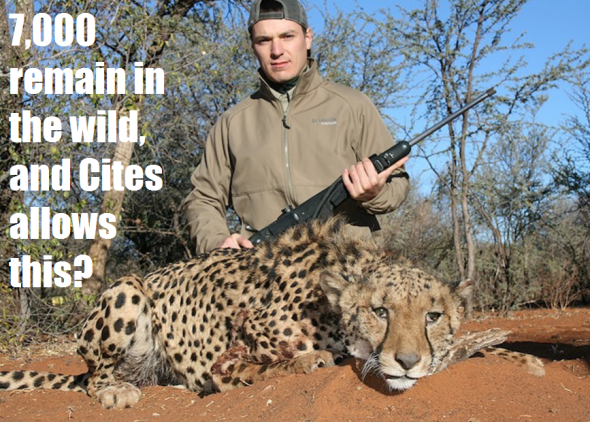 Image: Hunter, Canada - 7,000 to 10,000 Cheetah remain and this is allowed by Cites.
Image: Hunter, Canada - 7,000 to 10,000 Cheetah remain and this is allowed by Cites.
Within the African countries of Cameroon, Central African Republic, Congo, and Democratic Republic of Congo again population counts are not known. (Its’ quite possible that the species has already gone extinct). Cheetahs are already officially extinct within Burundi and Rwanda. Reports have sadly confirmed the species is also extinct within Nigeria. Poaching and over-hunting have wiped all populations out within the three central African countries. A 1974 study ‘suggested’ that few populations may be occupying both Cameroonian boundaries and Yankari Game Reserve. This report is though mere speculation and not confirmed evidence.
EXTINCTIONS TO DATE
Regional Extinctions
Extinctions have already occurred within; Burundi; Côte d’Ivoire; Eritrea; Gambia; Ghana; Guinea; Guinea-Bissau; India; Iraq; Israel; Jordan; Kazakhstan; Kuwait; Oman; Qatar; Rwanda; Saudi Arabia; Sierra Leone; Syrian Arab Republic; Tajikistan; Tunisia; Turkmenistan; United Arab Emirates; Uzbekistan and Yemen.
Possible Extinctions
Afghanistan; Cameroon; Djibouti; Egypt; Libya; Malawi; Mali; Mauritania; Morocco; Nigeria; Pakistan; Senegal, Uganda and the Western Sahara.
Known Endemic Zones
Algeria; Angola; Benin; Botswana; Burkina Faso; Central African Republic; Chad; Congo; Ethiopia; Iran; Kenya; Mozambique; Namibia; Niger; South Africa; South Sudan; Sudan; Tanzania, United Republic of; Togo; Zambia; Zimbabwe. (Updated 2015)
2015 WILD POPULATION COUNTS
(Please note the following populations below are wild and not captive nor farmed)
Reintroductions of Cheetah populations have taken place within Swaziland however to what extent the populations are within Swaziland is unknown.
What we know to-date is that populations within the “Southern Africa” (not just South Africa) hosts the largest populations at roughly some 5,000+ mature individuals. Botswana and Malawi holds roughly 1,800 mature individuals. Populations are unknown within (Angola) and ‘considered possibly extinct’. Mozambique holds some 50-60 mature individuals, Namibia 2,000. SOUTH AFRICA holds some 550 mature individuals, Zambia some 100 mature individuals, Zimbabwe 400. A large proportion of the estimated population lives outside protected areas, in lands ranched primarily for livestock but also for wild game, and where lions and hyenas have been extirpated. So we do question why trophy hunting and unregulated hunting still persists out of farmed areas.
Ethiopia, southern Sudan, Uganda, Kenya and Tanzania holds an estimated (2,500 mature individuals) however due to intense hunting pressure, poaching and habitat destruction this number could be much lower. (There is NO evidence that hunting within any of the ‘legal zones’ has increased Cheetah populations whatsoever”. Furthermore I challenge all hunting organisations within the legally allowed hunting areas to prove myself wrong? The largest population (Serengeti/Maro/Tsavo in Kenya and Tanzania) is estimated at 710.
Kenya hosts some 790+ mature wild individuals, Tanzania 560+ to 1,100 individuals. Uganda, Gros and Rejmanek (1999) estimated 40-295 with a wider range in the Karamoja region, whereas now Cheetahs have been extirpated and just 12 are estimated to persist in Kidepo National Park and surroundings. North-West Africa the species stands at no fewer that 250 mature individuals (if that).
Within Iran the ‘sub-species’ of Asiatic Cheetah - A. j. venaticus (if still extanct) stands at some 60-100 mature individuals. We do like the fact the conservation trustee is a known hunter allegedly supporting Cheetah conservation. We’ve yet to see an real improvement of Iranian Cheetahs in the country (more money talk)…
The overall “known Cheetah population” for Asia and Africa is by far more threatened that the Lion. To date there are some 7,000 known mature individuals remaining within the wild but no greater than 10,000. This sadly make the Cheetah by far more threatened than Panthera leo. African Lion populations stand at some 15,000 to 13,000 maximum. As the Cheetah population will not likely exceed 10,000 individuals - the species therefore qualifies for (vulnerable status).
Nowell and Jackson stated that Cheetah populations in the past have undergone some alarming declines, now it would seem that history is re-repeating itself (this time the specie may not survive). The Cheetah exhibits remarkable levels of genetic diversity in comparison and compared to other wild felids, so there could be a high chance the species may make it back from the near brink of extinction within the wild.
Problem is poaching and over-hunting then wasn’t as prolific as it is today. Scientists stated that interbreeding among other individuals had saved the species from bottleneck declines in the past. This history dated back some 10,000 years. Sport hunting then wasn’t an issue as it is today, so in all fairness the species could be hunted into extinction illegally or legally (with much thanks to Cites on the ‘legal part’). So in all honesty we may lose the Cheetah before the Lion.
While the causes of the Cheetah’s low levels of genetic variation are unclear [back then], what is clear is that large populations are necessary to conserve it. Since Cheetahs are a low density species, conservation areas need to be quite large, larger than most protected areas. Major areas of the African continent are being overtaken by humans, agriculture to cope with human expansion and deforestation. No longer is it a case of ‘if’ rather than ‘when’….
MAJOR THREATS
Cheetahs are ‘hunted for sport and trophies’, as well as handicrafts products. Live animals are also traded - the global captive Cheetah population is not self-sustaining. Pest animals are also removed.
In Eastern Africa, habitat loss and fragmentation was identified as the primary threat during a conservation strategy workshop (2007). Because Cheetahs occur at low densities, conservation of viable populations requires large scale land management planning; most existing protected areas are not large enough to ensure the long term survival of Cheetahs. A depleted wild ungulate prey base is of serious concern in northern Africa. Cheetahs which turn to livestock are killed as pests. Conflict with farmers and depletion of the wild prey base are also considered significant threats in parts of Eastern Africa.
In Iran, the Asiatic Cheetah A. j. venaticus is threatened indirectly by loss of prey base through human hunting activities. In addition, most protected areas are open to seasonal livestock grazing, which potentially places huge pressure on the resident ungulate populations through disturbance and potential competition. Additionally, domestic dogs accompanying the herds present a likely threat to both Cheetahs and their prey. An emerging threat is the possibility of fragmentation into discontinuous subpopulations as a result of increasing developmental pressures (mining, oil, roads, railways); this is particularly the case in Kavir N.P., currently the north-western limit of the Asiatic Cheetah’s range.
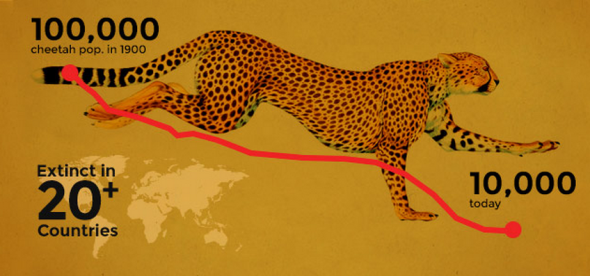 Image: Cheetah populations are more threatened than Lions.
Image: Cheetah populations are more threatened than Lions.
Conflict with farmers and ranchers is the major threat to Cheetahs in southern Africa. Cheetah are often killed or persecuted because they are a perceived threat to livestock, despite the fact that they cause relatively little damage. In Namibia, very large numbers of Cheetahs have been live-trapped and removed by ranchers seeking to protect their livestock (from government permit records, Nowell [1996] calculated that over 9,500 cheetahs were removed from 1978-1995). While removal rates have fallen, in part due to intensified conservation and education efforts, many ranchers still view Cheetahs as a problem animal, despite research showing that Cheetahs were only responsible for [3% of livestock losses] to predators. Although Cheetah in Iran have been killed because of predation on livestock, since 2003, there has been no direct evidence of killing Cheetahs, though it is likely most incidents go unreported.
“Cheetahs are also vulnerable to being caught in snares set for other species”.
Another threat to the Cheetah is interspecific competition with other large predators, especially lions. On the open, short-grass plains of the Serengeti, juvenile mortality can be as high as 95%, largely due to predation by Lions. However, mortality rates are lower in more closed habitats.
CITES [allows legal trade in live animals and hunting trophies under an Appendix I] quota system (annual quotas: Namibia - 150; Zimbabwe - 50; Botswana - 5). This was accepted by CITES as a way to enhance the economic value of Cheetahs on private lands and provide an economic incentive for their conservation. The global captive Cheetah population is not self-sustaining; Cheetahs [breed poorly in captivity] and in 2001 [30% of the captive population] was wild-caught. While analysis of trade records in the CITES database shows that these countries have reported almost no live exports since the late 1990s, Conservation groups are concerned that there is a substantial illegal cross-border trade in live animals.
There is also concern about illegal trade in skins, as well as capture of live cubs for trade to the Middle East. There is an increasing trade in cubs from [north-east Africa into the Middle East], but there is currently little trade in cubs from the Sahel region, where it was previously considered a major problem. Cheetahs are active during the daytime and there is concern that they can be driven off their kills by [tourist cars crowding around, or mothers separated from their cubs]. Burney (1980) conducted a study and concluded that [tourist cars did not seem to harm cheetahs, and in fact sometimes helped, as cheetah chases more often ended in a kill when there were cars around, distracting prey, providing cover from which to stalk, or otherwise waking Cheetahs up to notice prey in the area]. However, [tourist numbers have risen sharply by then, and its potential impact on cheetahs remains a concern].
The Eastern African Cheetah conservation strategy identified four sets of constraints to mitigating these threats across a large spatial scale. Political constraints include lack of land use planning, insecurity and political instability in some ecologically important areas, and lack of political will to foster Cheetah conservation. Economic constraints include lack of financial resources to support conservation, and lack of incentives for local people to conserve wildlife. Social constraints include negative conceptions of Cheetahs, lack of capacity to achieve conservation, lack of environmental awareness, rising human populations, and social changes leading to subdivision of land and subsequent habitat fragmentation. These potentially mutable human constraints contrast with several biological constraints which are characteristic of Cheetahs and cannot be changed, including wide-ranging behaviour, negative interactions with other large carnivores, and potential susceptibility to disease.
Disease is a potential threat to the Cheetah, as its reduced genetic diversity can increase a population’s susceptibility. However, the most serious disease mortality thus far documented in wild Cheetahs was from naturally occurring anthrax in Namibia’s Etosha National Park; Cheetahs, unlike other predators, do not scavenge carcasses of ungulates killed by anthrax, and thus [had no built-up immunity] when they preyed upon springbok sick with the disease. The Cheetah’s low density may offer some measure of protection against infectious disease; for example, Cheetahs were not affected by an outbreak of Canine Distemper Virus in the Serengeti National Park which [killed over 1/3 of the Lion population]. Serological surveys of Cheetahs on Namibian farmland indicate some exposure and survival of the disease.
We are losing the Cheetah faster than the specie of Lion. Although some regulations are in place with the species listed on Appendix I (Cites) its quite likely we’ll lose wild populations should hunting, poaching and unregulated hunting not stop now.
Thank you for reading.
Dr Jose C. Depre
Environmental and Botanical Scientist.
Sources; Cites, Red List, Wiki, Wild Forum, DEA, CCG, DSI, PHASA, Cambridge University, Oxford University.
Endangered Species Monday: Alaena margaritacea
Endangered Species Monday: Alaena margaritacea
This Mondays (ESP) Endangered Species Watch Post we take a brief glance at South Africa’s most endangered species of butterfly. Generically identified as Alaena margaritacea the species was primarily located by Dr Harry Eltringham FRS (18 May 1873, South Shields - 26 November 1941, from Stroud) whom was an English histologist and entomologist who specialized in Lepidoptera. (Image: unknown photographer)
Dr Eltringham had been awarded a Master of Science (Cantab and Oxon) and a Doctor of Science (Oxon). He worked at the Hope Department of Entomology. He wrote Histological and Illustrative Methods for Entomologists OCLC 03655743, The Senses of Insects, London, Methuen (1933) and on Lepidoptera Nymphalidae: Subfamily Acraeinae. Lepidopterorum Catalogus 11:1-65 with Karl Jordan (1913) and On specific and mimetic relationships in the genus Heliconius.
Commonly known as the Wolkberg Zulu butterfly and identified back in 1929 the species stands within ‘threatened’ status of which has qualified for vulnerable listing. Endemic to a wee small town of South Africa the butterfly is from the family Lycaenidae which is the (second largest family of butterflies on the planet), hosting some 5,000 species and, constitutes 30% of the butterfly species on Planet Earth.
A. margaritacea is known to inhabit grassy slopes adjoining afromontane forest in the Haenertsburg area of the Limpopo Province near the Wolkberg. Populations trends are currently not known however we do know that flora alien (non-native botanical specimens) are placing the only two known colonies of Wolkberg Zulu butterflies within that area in [extreme danger], back in 2013-2014 a second colony was located to the joy of many.
To give you a clearer image of just how threatened the species is (any such habitat disturbance within their known range could see extinction occur within days rather than months or years).
However its not all doom and gloom yet. There is hope, even within a country that’s habitat is slowly being destroyed by agriculture, aquaculture and urbanization. Three years ago the species was believed to have gone extinct. However an intensive search was mounted by members of the Lepidopterists’ Society of Africa.
Despite being identified back in 1929 the species has only ever been known to occur in one single location: a small town in northern South Africa in Polokwane within the town of Haenertsberg. The wingspan is 24–27 mm for males and 28–30 mm for females. Adults are on wing from late December to early January. There is one generation per year. Lepidopterists’ Society of Africa spokesperson Naturalist Andre Coetzer stated that as yet none has been able to locate a third colony (2014).
The species has a habit of settling very frequently and for very long periods … which makes searching for the butterfly a tedious, challenging task involving long treks over rocky terrain while combing and scrutinizing the grass and undergrowth. And there’s another problem: the Wolkberg Zulu has an extremely short flight period (the ‘winged’ adult part of its life cycle) – just three weeks in December and early January that also happens to fall right in the middle of the rainy season. All of this easily explains why no one has found another colony of this elusive and endangered butterfly in the last 80 years. Until now… Please read more here to learn more on the butterfly. For fuether information please contact the organisation directly - click here
A typical liquid diet consists of nectar from flowers but also eat tree sap, dung, pollen, or rotting fruit. They are attracted to sodium found in salt and sweat too.
The word Lepidoptera is derived from the Latin words “lepido” meaning scale, and “ptera” meaning wings. Lepidoptera literally means scale wings, referring to the minute scale-like structures on the wings of both butterflies and moths. We are unsure as to how many Wolkberg Zulu Butterflies actually live within the two colonies, there could be anything from 100-200 (random guess). Which is why we please ask all our readers to make a donation to the Lepidopterists Society of Africa to secure more projects.
Image: Wolkberg Zulu butterfly
For now we remain skeptical and whether there will be more colonies located. We are praying for more colonies to be located. The Department of Environmental Affairs must do more to protect their lands from invasive botanical species to ensure future survival of all flora and fauna. Not forgetting establishing a funding program, protected and manned area to secure their South Africa’s critically endangered butterfly. Failing this we’ll lose South Africa’s most rarest butterfly known to humankind.
Threats
The only known threat to be placing the species in direct danger are that of alien botanical species. Habitat destruction is not known to be problematic within the region although agriculture and human disturbance could very well become a problem. For more information on alien invasive species please see click here for further information.
Unfortunately folks we do not have a video to show of this amazing video but hope one is made available soon. Video footage of this amazing yet so very rare butterfly would be wonderful to view. Please don’t forget to check out the links above and, donate if you can to the group Lepidopterists’ Society of Africa.
Thank you for reading.
Dr Jose C. Depre.
Chief Environmental and Botanical Scientist.

